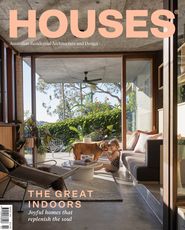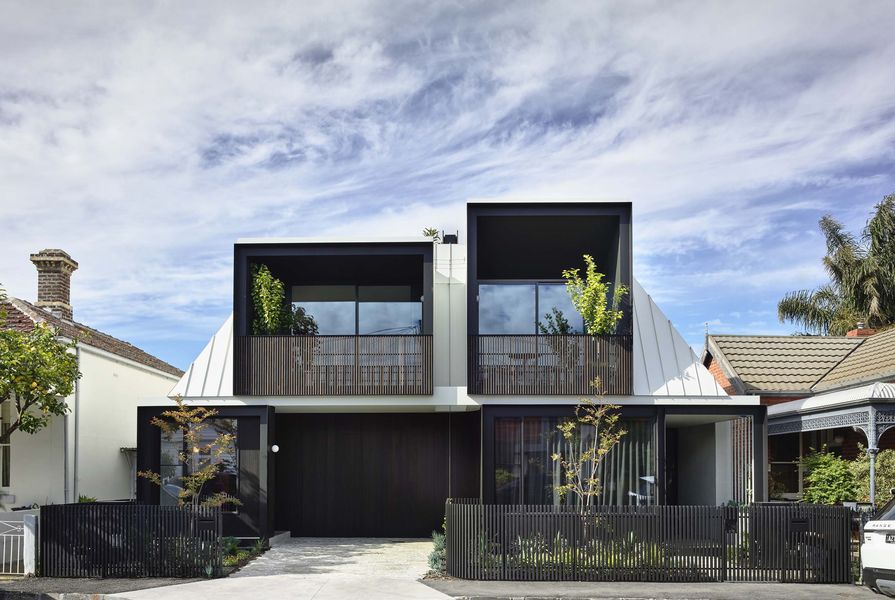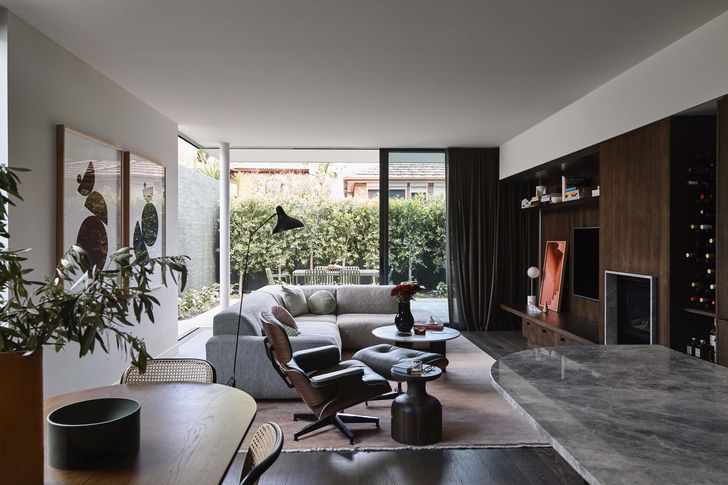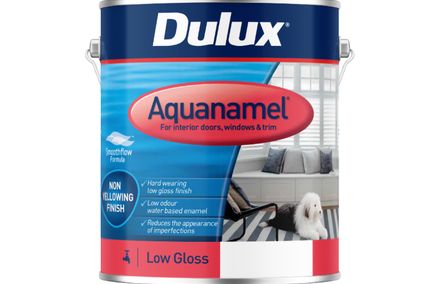“I’m very interested in observing how people dwell, play and work,” says architect Maria Danos, principal of Maria Danos Architecture. “If this [pandemic] year has taught us anything, it’s that there are a lot of convergences in those different aspects of our lives.” Ideas about convergence and adaptability underpin this project – a pair of compact but refined houses in Melbourne’s inner south-east.
The concept for the project drew on the area’s residential history. Housing stock in the surrounding streets, as in many of Melbourne’s inner suburbs, has been shaped by successive waves of migration. “I love these communities where you can see layers of different demographics – it’s quite revelatory, observing all the layers of postwar migration. There is no uniform voice,” Maria explains. “That’s community – it really excites me to see how much people can do with a small space and how much joy they bring to it. We don’t need to live large; we can live thoughtfully and well in a small space.”
Curved lines and custom joinery create a flowing transition between the kitchen and the living room. Artworks (L–R): Bobby Clark, Derek Swalwell.
Image: Derek Swalwell
The brief was shaped equally by the client’s professional experience in hospitality and construction management and by the desire to squeeze maximum value from the site while delivering an enviable standard of amenity. The resulting houses are like siblings – recognizably similar but not identical. They employ the same vocabulary, but with distinctly individual expression. Facing the street, for example, the bold, portal-framed balconies that characterize the houses’ exteriors are tweaked and customized – the eastern one is wider, thanks to a splayed balcony wall, while its western counterpart is taller and boxier. The balconies push out from the angled walls of the houses’ upper level. “Angling the walls funnels light into the house’s centre,” Maria says. A strong datum references the verandah heights of the neighbouring properties.
The differences in the two houses are evident in plan, too. While most of the floor plate is mirrored along the central party wall, the houses’ north-facing entry experiences are unique. “The northern orientation meant that the ground-floor spaces couldn’t just be given over to entry; they needed to work hard,” Maria explains. In the eastern house, this means a single-car garage with a narrow home office running alongside. The front door to the western house is set back further, opening to a small study that steps through to a larger studio space, which could comfortably accommodate a small team of professionals. A large picture window gazes out to the front garden. “It’s about finding that sweet spot between visual permeability and privacy,” says Maria.
Henry Street Townhouses by Maria Danos Architecture. Artwork: Bobby Clark.
Image: Derek Swalwell
Beyond these entry zones, a curvilinear stair breaks up the regularity of the scheme. “When you’re dealing with narrow footprints, a rolled wall is far more forgiving than a rectilinear wall. It creates sculptural elements. It helps with spatial flow and makes those spaces less restrictive,” Maria says. A void connects the upper and lower floors and floods the interior with light. Up top, the stair steps out to a compact roof terrace that looks back toward the CBD.
There is a richness in the houses’ materiality that comfortably bridges the elegant and the dynamic. Maria steered her client away from light timbers, opting instead for a richer, mid-tone Tasmanian oak. “I wanted it to look clean and crisp, to wear well. I didn’t want the interior to feel like a hospitality venue; I wanted it to feel like a home.”
The practice’s deft touch for flexible and cohesive interiors is evident throughout, from the inbuilt desks in the upstairs bedrooms and on the landing to the thoughtfully composed joinery in the kitchen, which flows through into a plinth running the length of the living room. The materials palette is pared back, matching that warm oak with variegated grey dolomite surfaces, coir and timber flooring, and understated light fittings.
Inbuilt desks nestle beneath the upstairs bedrooms’ angled walls.
Image: Derek Swalwell
Central to the brief was the clients’ desire to create as much garden as possible on the site. “We wanted the side setbacks to have as much life as the front and the rear,” Maria explains. At the rear of the ground floor, a pair of cavity sliders retracts to connect the open living and dining zone to the courtyard garden. With the sliders open, a slender white post defines the corner of the room – a nod to modernist tradition. “All of a sudden you’re blurring the threshold,” Maria says. “There is something beautiful about expressing structure.”
You can’t help thinking that in designing this project, Maria was keeping one eye on the future. At its heart is an implicit acknowledgement that the way we live – the configuration of households, the functions we demand from our dwellings – is changing. “Communities are not made up of just nuclear families. Especially after the last year, we’ve been constantly exploring how we can plan spaces to anticipate all of the activities people might one day require from what was previously just a home,” she says.
Products and materials
- Roofing
- Lysaght Klip-lok roof decking in Colorbond ‘Surfmist’; folded vertical standing seam roof cladding in Colorbond ‘Surfmist’
- External walls
- Wire-cut common bricks, bagged and painted; Beyond Timber cedar shiplap cladding in Rubio Hybrid Wood Protector ‘Charcoal’; James Hardie Scyon Axon cladding; standing seam wall cladding in Colorbond ‘Surfmist’
- Internal walls
- Stained Tasmanian oak timber veneer, quarter cut; Polytec Ravine prelaminated board in ‘Cafe Oak’
- Windows
- Capral aluminium frames in Dulux ‘Monument’; custom timber frames; Viridian Sunergy double glazing
- Doors
- Designer Doorware Prisma levers in Dulux ‘Mannex Black’
- Flooring
- Perfect Oak Floors Eire engineered timber boards; Bardwell coir matting; Supertuft Escape Twist carpet in ‘Gigi’ Lighting: Artemide Dioscuri wall lights; Visi downlights from LPA; Giffin Design Simple sconce and custom stair lighting
- Kitchen
- G-Lux Silver Ash stone benchtops; stained Tasmanian oak timber veneer joinery; Castella Gallant joinery pulls; Franke Kubus sink; Phoenix tapware in ‘Gun Metal’; Fisher and Paykel oven, cooktop, rangehood and fridge; Miele dishwasher
- Bathroom
- Slabshapers Merchant basin; Phoenix tapware in ‘Gun Metal’; G-Lux Silver Ash stone benchtops; porcelain and mosaic pencil tiles from Academy Tiles; rectangular ceramic tiles from Byzantine Design
- Heating and cooling
- Earthwool insulation; Rinnai fireplace from Victorian Fireplaces
- External elements
- Loden Quartz Traditional Filleti and limestone paving from RMS Traders
- Other
- Custom solid timber handrail to curved stair by Charles Sandford
Credits
- Project
- Henry Street Townhouses
- Architect
- Maria Danos Architecture
Melbourne, Vic, Australia
- Project Team
- Maria Danos, Jack Tu
- Consultants
-
Builder
Larik Constructions
Engineer Page-Green and Associates
Landscape architect Mud Office
- Aboriginal Nation
- Built on the land of the Boon Wurrung and Wurundjeri people of the Kulin Nation.
- Site Details
-
Location
Melbourne,
Vic,
Australia
Site type Suburban
Site area 370 m2
Building area 420 m2
- Project Details
-
Completion date
2020
Design, documentation 13 months
Construction 12 months
Category Residential
Type New houses
Source

Project
Published online: 13 Aug 2021
Words:
Peter Davies
Images:
Derek Swalwell
Issue
Houses, April 2021



























